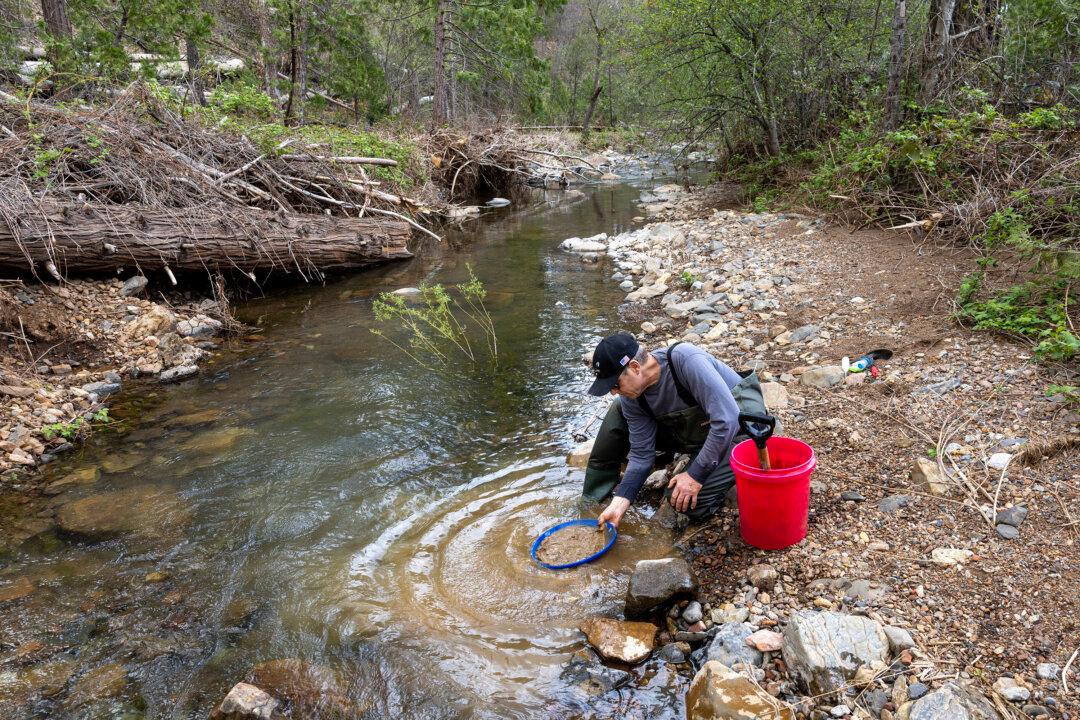Buck Meadows—For 170 years, the gold deposits along Sierra stream beds have been so poked and prodded that easy supplies of the precious metal have grown scarce and are a challenge to find.
This spring’s raging rivers are regifting them.
“There it is!” said Kevin Bell of Sacramento, swirling a pan in the cold waters of Moore Creek, as glitter suddenly illuminated the inky black sand. A half bucket of material yielded 12 showy specks—nearly a tenth of a gram of gold, worth about $7—about double the typical haul in previous years.
Prospectors call it “flood gold”—fine-sized flakes carried by alluvial waters and then deposited as flow recedes.
This winter’s hard and heavy storms caused strong bursts of erosion, with rain pounding rocks near the lode sources and rinsing gold downstream. Fierce springtime flows are churning up river bottoms, causing gold to be dredged from deep pockets and dense clays, where the biggest nuggets may hide. Rivers are shifting gravel bars from one place to another. They’ve ripped out undergrowth, offering easier access. During the drought, nothing moved.
“What happened this winter was magnificent,” said Kevin Hoagland, director of the Gold Prospectors Association of America, which has over 50 claims on 6,000 acres for membership use only.
“It takes a very significant event to move gold,” he said. “But this wasn’t a singular event. It was a succession of significant events.”
The news is swelling the ranks of amateur prospectors, in step with the skyrocketing price of gold, which hit a near-record of more than $2,000 an ounce this week, up from $1,700 last November.
“People from all over the world are coming in. There are languages I can’t even understand,” said Albert Fausel of Placerville Hardware, founded in 1854 and the longest-running hardware store west of the Mississippi.
“They’re buying pans, crevice tools, ‘snuffer bottles,’ metal detectors, all the bare necessities,” he said. “I just sold a pair of gloves to a guy who wanted to keep his hands warm.”
Within persistent cool springtime conditions, many of California’s most storied rivers—such as the Yuba, American, Cosumnes, Tuolumne, Merced, and Klamath—are still flowing too fast for safe panning.
So prospectors are exploring smaller creeks and scanning riverbanks with metal detectors.
“People don’t understand how powerful water is. They’ll put their foot in it and just get sucked in,” said Bell, 61, a skilled prospector with a slow stride and a voice as rough as 40-grit sandpaper. “You need to think safety all the time.”
Bell parked his truck at the end of a long dirt road, near an old stagecoach stop. Wearing hip waders, and carrying a shovel and bucket, he trudged through a forest of cedar, pines, oaks, and blackberry tangles, then climbed down into Moore Creek.
As cold and clear as chilled gin, the creek originates in drainages outside Yosemite National Park and tumbles down into the North Fork of the Merced River. The region is underlain by quartz veins, rich in ore.
Gold mining began here in 1849 when James Savage, led by Native Americans of the area, discovered gold near the present-day towns of Big Oak Flat and Groveland, according to the Southern Tuolumne County Historical Society.
Thousands of miners converged on these pine-covered western foothills of the Sierra in search of wealth, helping create a state. By the 1870s, supplies of easily exploitable gold were largely exhausted. Improved technologies led to a second smaller commercial boom in the early 1900s, then a third in the 1950s. Then it ceased.
Now the area prospers largely from the tourist trade.
A retired manager for a municipal utility, Bell is motivated less by hopes of striking it rich than by being outdoors among friends. To be sure, he’s done well: On a nearby claim in 2012, he discovered 2.5 grams of gold in a single pan, including a stunning 3/4-gram nugget. But he doesn’t sell the gold he finds; rather, he’s built a collection of memories, each vial representing an adventure in a cherished place.
Wading the creek, he scanned its banks for signs of the high water mark—debris, flattening of brush or grass and new gravel deposits in high benches, where gold may have been pushed up and deposited. “It tells you the scope of where the water has been working,” he said.
Prospectors’ eyes are trained to look for opportunity: Eddies, abrupt shifts in direction caused by downed trees, and slack water “drop-out zones,” where gold, 19 times heavier than water, will fall as flow slows.
“It’s all about letting nature talk to you, and understanding the nuances,” said Hoagland.
“Just one tiny change—little pieces of sticks that have been pushed by water, that are all pointing the same direction—those are things that we are constantly looking for,” he said. “Because that tells us the flow pattern, and where there was energy at one particular time. You ask: Where did this water slow down? How are the gravels laid out?”
Bell focused on an eroded bank, blasted by water. Water levels had surged up into grass and fallen, then were deflected by a log.
“It’s a natural chokepoint for water,” he said, shoveling mud into his bucket and then into a blue pan. “Now gold has a place to hide.”
He bent down, filled the pan with water and swirled the muddy mix. He sorted out the larger pebbles and washed the lighter dirt over the rim.
He lowered his face to the pan. Yellow flecks glimmered in the sunlight. Arizona gold has a bronze hue; Alaskan gold trends silver. California gold is typically buttery yellow and flat, due to water pounding.
“See how the gold is shining in the light?” he marveled. “It has an aura that doesn’t change.”
“It’s about the quest,” he said. All winter, while he watched and waited, “I knew this area would be rich. And it was.”
Copyright 2023 MediaNews Group, Inc. Visit at mercurynews.com. Distributed by Tribune Content Agency, LLC.






